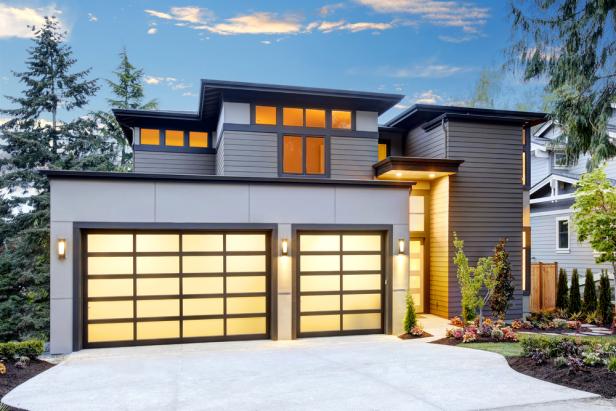How to Replace a Garage Door Spring
Learn how to identify a damaged or broken garage door spring and determine what it may take to get your door back in working shape.

Garage doors are heavy and maintaining their springs is critical to their function. The springs are responsible for the even distribution of the weight of your garage door. If they snap while you’re opening or closing the door, no doubt it will be quite a shock and an inconvenience you’ll want to solve fast.

Shutterstock
The average garage door spring should last about 10,000 cycles of opening and closing. For the average homeowner, that’s about 14 years! But if you recently bought your home and don’t know the age of the springs, be prepared to identify and correct any issues as early as possible.
Signs of garage door spring damage include:
- a sudden, loud snapping sound
- the door opener won’t lift the door
- the door closes unexpectedly fast
- the door is crooked
- the springs are visibly stretched out, no longer a tight coil
When a spring breaks, it can easily trap your vehicle inside if you’re not strong enough to manually lift your garage door.
Replacing a garage door spring yourself isn’t impossible, but it does require special knowledge about the springs and how a garage door works. To help homeowners who are interested in learning how to replace a garage door spring, let’s take a closer look at how residential garage doors operate.
If you realize during this overview that your garage door relies on torsion springs, or if you're not comfortable with the process, hire a garage door professional who can safely make the repair.
Parts of a Garage Door
Garage doors use a system of pulleys, cables and either extension springs or torsion springs. The pulleys are steel wheels or drums that the garage door cables wrap around to transfer the force of the springs and support the weight of the door as it opens and closes. This engineering is what makes it possible to lift a heavy garage door with a single motion.
The Two Types of Garage Door Springs
Extension springs are most common for residential garage doors. These springs are usually referred to as standard or early-set torsion springs.
Steel rolling-door and torque-master springs can be used for residential homes but are most often used in commercial and industrial sites with much heavier garage doors.
Choosing the right product for a garage door spring replacement is critical.

Shutterstock
Double-looped extension spring on a residential garage door.
Extension Springs
Ordinary residential garage doors are often installed using ordinary extension springs. Extension springs are long, narrow springs that run parallel to the door’s horizontal tracks. These garage door springs store energy by extending and stretching when the door is moved. This energy is transferred, which makes it easier to open and close a garage door. Extension springs for most residential uses are either open-looped, double-looped or clipped-end.
Open-looped extension springs
Open-looped springs are some of the easiest to replace because they don't require opening the eyebolt or disassembling the pulley; however, they're also weaker than other products and not strong enough for heavy doors. They rely on an open wire at the end, but if the wire breaks, the entire extension spring needs to be replaced.
Double-looped extension springs
Double-looped extension springs are a stronger option for residential garage doors. They have two coils at the end of the spring. These coils connect to the pulley and eyebolt. They are easy to install and offer more durability but still lack the strength needed for an oversized or heavy garage door.
Clipped-end extension springs
Clipped-end springs are recommended for heavier residential garage doors. Professionals like them because they will last longer than single and double-looped extension springs. The clips make it possible to offset stress on the spring, so it's easier for them to reliably carry weight. Older doors made of wood or other heavy materials benefit from clipped-end extension springs. That said, if your existing garage door had a clipped-end spring, consider weighing the benefits of upgrading to a torsion spring.

Shutterstock
Torsion spring installed on a home garage door.
Torsion Springs
Torsion springs are high-performance and useful for both heavy residential garage doors and commercial or industrial buildings. A garage door can have multiple torsion springs, always depending on its size and weight. Torsion springs are broader than narrow expansion springs and can be found on a metal shaft directly above the door opening. Some are exposed, while others are safely enclosed.
When torsion springs are installed, aluminum drums are placed on either end of the metal shaft. The springs are wound to a specific torsion setting relative to the garage door size and weight. These springs are labeled as standard, early-set or torque-master springs.
Standard torsion springs
These are the most used springs for residential garage doors. A standard torsion spring is designed with a stationary cone and secured with a spring anchor bracket. Many lightweight doors only require the use of one torsion spring, but some professionals will recommend two to enhance safety and durability.
Early-set torsion springs
These easy-mount torsion springs are installed in the middle of the torsion shaft, rather than at the ends of the shaft. The positioning of the springs makes them perfect for wider, two-car garage doors. Many professionals also favor this design because it's an easy system to install — the spring can be wound using a drill!
Torque-master torsion springs
You won't usually find these springs on an ordinary residence. They are often installed on commercial and industrial buildings with steel rolling doors. Torque-master springs are also enclosed, making them safer than other types of garage door springs but harder to lubricate and maintain. Their winding cone is located on the torsion rod, which helps to keep them in place. Characteristically, they will last longer and require less maintenance during their lifetime.
Dangers of replacing any spring include:
- falling garage doors
- activated openers during replacement
- cuts due to old or rusty metal
- injury or property damage from flying metal if a spring breaks
Compare Costs
With a little know-how and patience, many broken garage door springs can be replaced for less than $100 in materials. In contrast, a professional may charge upwards of $300 for a garage door spring replacement. Installation and product costs can always vary based on the size of the spring and type of spring that's required for your garage door.
While replacing the spring yourself may save you money, a professional may be able to complete the job faster while avoiding the hazards that come with this chore. If you aren’t comfortable doing this task yourself, you may want to hire it out the first time to observe how a professional makes the repair.
Install a Replacement Garage Door Spring
This tutorial provides an overview of the process of replacing an extension spring on a garage door. Keep in mind that the type of garage door you have (including the size, age and weight) can affect many aspects of the installation.
Tools and Materials
- locking pliers
- tape
- socket wrenches
- screwdriver or drill with phillips head bit
- replacement spring
1. Identify the Type of Spring
Following the descriptions above, identify your type of garage door spring. Check the orientation of your garage door spring to determine if you have a common extension spring.
Finding and buying a replacement spring for the garage door shouldn’t be difficult, provided you’ve taken measurements beforehand and determined what type of spring you need. The spring manufacturer or the garage door manufacturer is a great source of information and can usually supply you with a replacement product for your exact door. They can also be a resource to answer questions and supply instructions.

Shutterstock
Torsion spring on a commercial garage door marked a blue color for easy identification.
Extension springs are commonly color-coded with a repeating pattern that indicates the amount of weight they can lift.
Purchase a new spring that matches the color of the current spring:
- Tan: 100 pounds
- White: 110 pounds
- Green: 120 pounds
- Yellow: 130 pounds
- Blue: 140 pounds
- Red: 150 pounds
- Brown: 160 pounds
- Orange: 170 pounds
- Gold: 180 pounds
- Light Blue: 190 pounds
If you can’t determine the manufacturer or model, take photos of the springs and bring them to a hardware store. Or you may have to call a pro to come to your home and help you identify what parts you'll need to replace.
3. Disconnect Old Spring
Disconnecting the existing extension spring is not as dangerous as managing spring tension with torsion springs. Start by opening the garage door to relieve all remaining tension. The door will need to remain upright and in place. You may choose to prop a 2x4 board beneath the door track to support its weight.
4. Disconnect Garage Door Opener
Use a piece of tape to mark the current placement of the pulley so that the garage door opener can be reinstalled at the same place.
5. Disconnect Spring + Safety Cable
Disconnect the spring from the track bracket and the spring pulley. You’ll notice a garage door cable is threaded through the spring to hold it in place. That safety cable can be detached from the bracket.
6. Add New Cable to Spring
With the replacement garage door spring ready to install, thread the safety cable through the new spring and attach it to the track bracket.
7. Reattach Safety Cable + Pulley
Reattach the safety cable and the pulley. Make sure the wire from the pulley is kept away from the safety cable. Referencing the tape marking you made before removing the pulley, make sure the pulley is installed in the correct location.
8. Reconnect Opener
Connect the garage door opener and remove any clamps or braces keeping the door upright.
9. Test the Door
Stand back and test the garage door. If the door doesn’t close all the way or closes too quickly, inspect the location of the pulley and the extension spring hardware.
Make adjustments until the spring smoothly lifts and lowers.

Shutterstock
Should You Replace Both Garage Door Springs?
Extension springs are replaced individually, but it isn’t likely that they’ll snap at the same time. Many homeowners take this as a sign to only replace one at a time; however, most professionals will advise you that if one of your extension springs breaks, you may as well replace them both. If one breaks, the other may soon follow. Perform a visual inspection to see if the spring that's still functional shows signs of wear. If you don’t replace both at the same time, you may need to do it again in the near future.
Torsion springs require more disassembly to replace them, so it always makes sense to swap out both springs even if just one breaks.
50 Garage Door Design Ideas 50 Photos
A garage door can make up a large portion of your home's exterior design. Lucky for us, they have come a long way from the boring builder-grade choices. Take inspiration from some of our favorite designs to add instant beauty to any home.
Garage Door Buying Guide
Before you buy, learn about the options, cost and how well they are insulated.















































